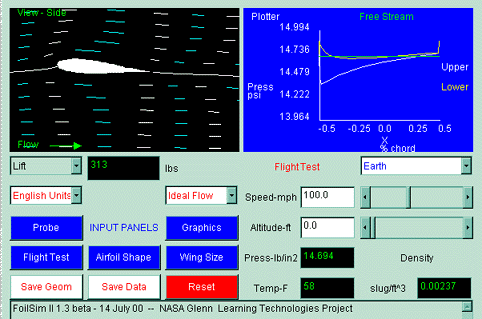|
|
Lift
vs. Airspeed
Subject Area: Algebra
II
Grade Level: 10
- 12
National Mathematics
Standards:
- Construct and draw
inferences from charts, tables, and graphs that summarize data from
real-world situations.
- Use curve fitting
to predict data.
- Make and test conjectures.
National Technology
Standards:
- Technology research
tools: Use content-specific tools, software and simulations (e.g.,
environmental probes, graphing calculators, exploratory environments,
Web tools) to support learning and research; select and use appropriate
tools and technology resources to accomplish a variety of tasks and
solve problems.
- Problem-Solving
and Decision-Making Tools - Routinely and efficiently use on-line
information resources to meet needs for collaboration, research, publications,
communications, and productivity.
Objective:
After reading
the explanation given below, use FoilSim and a graphing calculator to
complete the activity to determine the relationship between airspeed and
lift of an object by interpreting data.
FoilSim is an interactive
simulation software package that examines the airflow around various shapes
of airfoils. As you change parameters such as airspeed, altitude, angle
of attack, thickness and curvature of the airfoil, and size of the wing
area, the software calculates the lift. The package was created at the NASA
Glenn Research Center.
FoilSim II is a Java applet program that executes inside the browser of your computer.
It is available on the World Wide Web at
http://www.grc.nasa.gov/WWW/K-12/airplane/foil2.html.
You can also
download the program to run off-line.
Shown below is a screen
shot from the program's controls and displays. You may change the values
of the variables by using the slider or the input box on the left of the
slider.
To use the slider:
- Click the mouse
pointer on the arrows at the ends of the slider.
- Click the mouse
pointer anywhere between the slider and the arrow.
- Drag the slider
with the mouse.
To use the input
box:
Simply select the
value in the input box, key in the new value, and press Enter or Tab when
finished. The button on the slider will move corresponding to the value
typed in the box.

To begin the problem,
click on Lift vs. Airspeed.
Assessment:
You, or you
and your partner(s), will be evaluated on the feasibility or accuracy
of your answers.
Evaluation:
You will
be able to use FoilSim and a graphing calculator to complete the activity
to find and analyze the regression equation for the relationship between
the Airspeed and Lift of an object.
Submitted by:
Dalette Dawson, Brunswick High School, Brunswick, Ohio.
|
|
